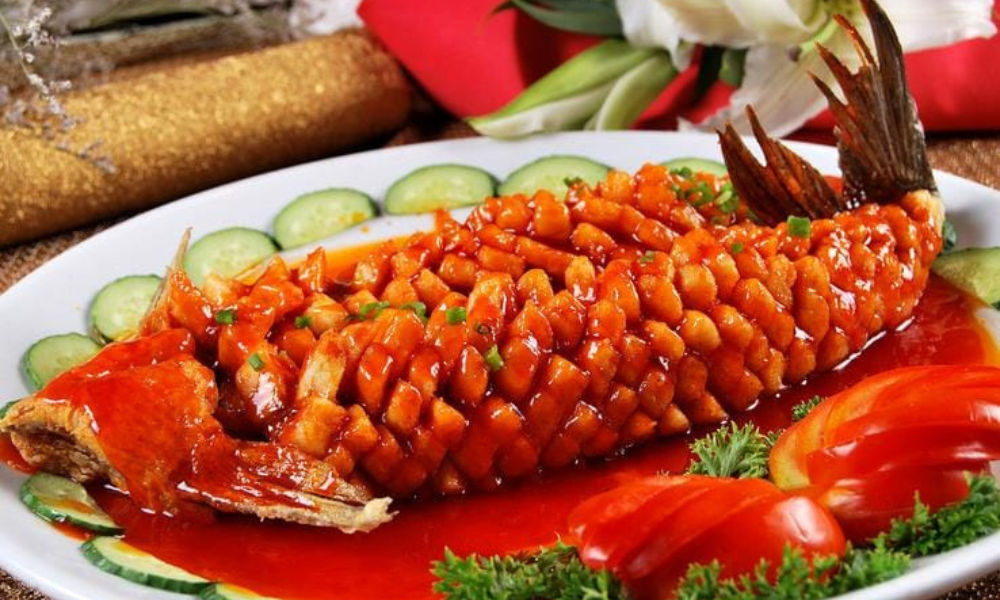Squirrel Fish Recipe
Ingredients
For The Vinegar Mixture:
- 3 tbsp Sugar
- ½ cup Hot Water
- 1½ tsp Corn Starch
- 6 tbsp White Vinegar
- 3 tbsp Pineapple Juice
- Salt To Taste
- ⅛ tsp White Pepper
For The Tomato Mixture:
- 1 tbsp Ketchup
- 2½ tbsp Tomato Paste
- 1½ tbsp Water
For The Fish:
- ⅙ tsp White Pepper
- Salt To Taste
- 2 tsp Apple Cider Vinegar
- ¼ tsp Sesame Oil
- 1 Egg Yolk
- ⅔ cup Corn Starch
- Oil For Frying
- 2 tbsp Onions
- 1 tbsp Peas
- 1 tbsp Pine Nuts
Instructions
Make The Sauce Mixtures:
- In a medium bowl, dissolve the sugar in ½ cup of hot water, and mix in the cornstarch, white vinegar, pineapple juice, salt, and white pepper.
Make The Tomato Mixture:
- In a separate small bowl, mix the ketchup, tomato paste, and 1½ tablespoons hot water until smooth.
Fillet The Fish:
- First, place your knife diagonally across the fish, just behind the head, collar and pectoral fins. Slice into the fish until you reach the backbone. Turn the fish so the belly is towards you. Place your knife at the head end, just above the backbone. Angle your knife blade slightly up (away from the backbone), and run the knife along it, pulling the meat up as you cut between the fillet and the bone. Then with your knife perpendicular to the fish, finish slicing the fillet from head to tail, using the backbone as a guide and stopping about 1-inch short of the tail. Flip the fish over and do the same on the other side.
- Next, cut the spine of the fish at the base of the tail. This will separate the tail and the two attached fillets from the rest of the fish.
- Using the heel of your knife, make a cut through the backbone just behind the head and the collar. The head should be able to sit on a flat surface with the mouth pointed up at an angle and each side of the pelvic fin portion of the fish flared to each side, supporting the head. The meat on the pelvic fin area can be a delicacy or fishy depending on the fish, so this is primarily for presentation. You may need to use your cleaver to flatten it slightly, so it sits at the correct angle. Set aside.
- Back to the fillets. With your knife at a slight angle, carefully score the fillets lengthwise—deep enough to reach the skin beneath without actually cutting through the skin. (Slicing the fish at an angle makes each segment longer with more surface area, and also helps prevent the knife from cutting through the skin.)
- Space the cuts ½ inch apart (you should be able to make 3-4 cuts easily, depending on how fat your fish is). Next, score the fish crosswise (again, at an angle), cutting down and away from the tail. Once again, make the cuts deep enough to reach the skin without cutting through it. This will create a crosshatch pattern. Each fillet segment should be roughly a ½-inch square.
- Dip the fish into an ice bath to rinse off any debris from processing and to tighten up the meat. Pat thoroughly dry with a paper towel. You should have two pieces: the head with the pectoral fin pieces attached and one large tail piece with the two cross-hatched fillets attached to it.
Dredge The Fish:
- In a large bowl, combine the salt, white pepper, clear rice wine, sesame oil, and egg yolk. Coat the fish–the head and the fillets with the tail–in the mixture, ensuring all the nooks and crannies are covered.
- Pour the cornstarch onto a small sheet pan and dust the fish with it, thoroughly coating all of the nooks and crannies and shaking off any excess. You may have to repeat the process for full coverage. If desired, you can wedge a half a toothpick between the top and bottom of the fish mouth so it stays open during the frying process.
Fry:
- Heat 6 cups of oil in a wok to 425°F.
- Now you’re ready to fry the big piece of fish with the fillets. First, use one hand to grab the fish by the tail. With your other hand, use a pair of tongs to grab the opposite end, clamping the two fillets together by the skin so the skin is facing up, and the cross-hatched pieces curl and flare outward. Lower the fish into the oil carefully for 10-15 seconds to set the shape, keeping both ends of the fish out of the oil. This not only allows you to hold onto either end safely, it gives the fish a slight curled shape. (If preferred, you may use 2 pairs of tongs, though it may be harder to maintain a good grip on both ends of the fish.)
- When the cornstarch coating is fried to the point that the two fillets are grafted together, release the fish gently into the oil, and let it fry for 5 minutes. The temperature will have lowered when the fish was added to the oil—keep it at 350°F/175°C. The fish should keep its shape (the fillets shouldn’t float apart in the oil). Do not move or flip the fish. Just use a wok spatula or ladle to carefully spoon the hot oil over the top of the fish for even frying. After 5 minutes, use a wide spatula to carefully lift the fish out of the oil (it’s a good time to grab a kitchen assistant!), and transfer it to an oblong serving plate.
- Next, fry the fish head until golden brown, again ladling the oil over any exposed areas. After 4 to 5 minutes, when the fish head is a light golden brown, lift the fish head out of the oil using a strainer/spider and spatula, and let any excess oil drain off. Place the fried fish head at the front of the fish, with the pelvic fins flanking the head on either side. Remove the toothpick if you used one.
Finish The Dish:
- Place the pine nuts into a fine-mesh strainer and lower them into the oil. Fry for 30 seconds Transfer to a plate lined with a paper towel to drain. Carefully transfer the hot oil to a different pot (you can use a clean, dry ladle to do this), and leave about 2 ½ tablespoons in the wok.
- Prep the peas. Blanch in boiling water until hot, for about 15-30 seconds. You can also microwave them for 1-2 minutes until hot, but still bright green. Drain and set aside.
- Heat a wok over medium heat. To the 2½ tablespoons of the frying oil remaining in the wok, add the onion, and stir-fry for 30 seconds, until fragrant but not browned. Add the tomato paste and ketchup mixture, and stir constantly for 30 seconds to cook. Give the water and vinegar mixture a good stir and add it to the wok. Bring to a simmer until the sauce is just thick enough to coat a spoon. It should be thin enough to pool around the fish and be absorbed into the fish when it is poured over.
- Spoon the sauce over the fish, sprinkle the peas and pine nuts over the top, and serve!








